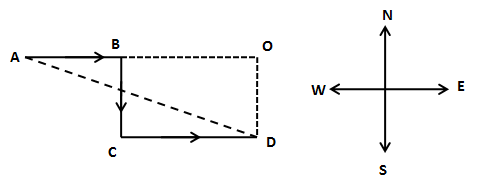
A man travels a distance of 1.5 m towards east then 2 m towards south and finally 4.5 m towards east. What is the total distance travelled and displacement?
Answer
558.6k+ views
Hint: The distance travelled by the man is the distance travelled along every direction. The displacement of the man is the position of its final point minus the position of its initial point. You can use Pythagoras theorem to determine the displacement.
Formula used:
Displacement of the body,
\[S = {x_f} - {x_i}\]
Here, \[{x_f}\] is the final distance and \[{x_i}\] is the initial distance.
Complete step by step answer:
We assume the man has started the journey from point A towards east and reached point B which is 1.5 m. Then he moved towards the south and reached point C which is 2 m. And then finally he travelled towards the east and reached at point D 4.5 m away from the point C. We can picture the journey of the man as shown in the figure below.

From the above figure, the total distance travelled by the man is,
\[d = AB + BC + CD\]
Substituting 1.5 m for AB, 2 m for BC and 4.5 m for CD in the above equation, we get,
\[d = 1.5 + 2 + 4.5\]
\[ \Rightarrow d = 8\,{\text{m}}\]
Now, we know that the displacement is the difference between the final position and the initial position. Therefore, the displacement of the man is AD. From the above figure, we can express AD as,
\[A{D^2} = A{O^2} + O{D^2}\]
Or,
\[A{D^2} = {\left( {AB + BO} \right)^2} + B{C^2}\]
Substituting 1.5 m for AB, 2 m for BC and 4.5 m for BO in the above equation, we get,
\[A{D^2} = {\left( {1.5 + 4.5} \right)^2} + {2^2}\]
\[ \Rightarrow A{D^2} = 36 + 4\]
\[ \Rightarrow A{D^2} = 40\]
\[ \Rightarrow AD = \sqrt {40} \]
\[ \therefore AD = 6.32\,{\text{m}}\]
Therefore, the displacement of the man is 6.32 m.
Note:
Students should understand the common difference between distance and displacement. The distance is the total distance covered by the body along any path whether it is circular or linear while the displacement of the body is the distance between the final position and initial position. If you start from a certain point and end up the journey at the same point, the displacement of the body is zero.
Formula used:
Displacement of the body,
\[S = {x_f} - {x_i}\]
Here, \[{x_f}\] is the final distance and \[{x_i}\] is the initial distance.
Complete step by step answer:
We assume the man has started the journey from point A towards east and reached point B which is 1.5 m. Then he moved towards the south and reached point C which is 2 m. And then finally he travelled towards the east and reached at point D 4.5 m away from the point C. We can picture the journey of the man as shown in the figure below.

From the above figure, the total distance travelled by the man is,
\[d = AB + BC + CD\]
Substituting 1.5 m for AB, 2 m for BC and 4.5 m for CD in the above equation, we get,
\[d = 1.5 + 2 + 4.5\]
\[ \Rightarrow d = 8\,{\text{m}}\]
Now, we know that the displacement is the difference between the final position and the initial position. Therefore, the displacement of the man is AD. From the above figure, we can express AD as,
\[A{D^2} = A{O^2} + O{D^2}\]
Or,
\[A{D^2} = {\left( {AB + BO} \right)^2} + B{C^2}\]
Substituting 1.5 m for AB, 2 m for BC and 4.5 m for BO in the above equation, we get,
\[A{D^2} = {\left( {1.5 + 4.5} \right)^2} + {2^2}\]
\[ \Rightarrow A{D^2} = 36 + 4\]
\[ \Rightarrow A{D^2} = 40\]
\[ \Rightarrow AD = \sqrt {40} \]
\[ \therefore AD = 6.32\,{\text{m}}\]
Therefore, the displacement of the man is 6.32 m.
Note:
Students should understand the common difference between distance and displacement. The distance is the total distance covered by the body along any path whether it is circular or linear while the displacement of the body is the distance between the final position and initial position. If you start from a certain point and end up the journey at the same point, the displacement of the body is zero.
Recently Updated Pages
Master Class 11 Economics: Engaging Questions & Answers for Success

Master Class 11 English: Engaging Questions & Answers for Success

Master Class 11 Social Science: Engaging Questions & Answers for Success

Master Class 11 Biology: Engaging Questions & Answers for Success

Class 11 Question and Answer - Your Ultimate Solutions Guide

Master Class 11 Business Studies: Engaging Questions & Answers for Success

Trending doubts
10 examples of friction in our daily life

One Metric ton is equal to kg A 10000 B 1000 C 100 class 11 physics CBSE

Difference Between Prokaryotic Cells and Eukaryotic Cells

1 Quintal is equal to a 110 kg b 10 kg c 100kg d 1000 class 11 physics CBSE

State the laws of reflection of light

Explain zero factorial class 11 maths CBSE




